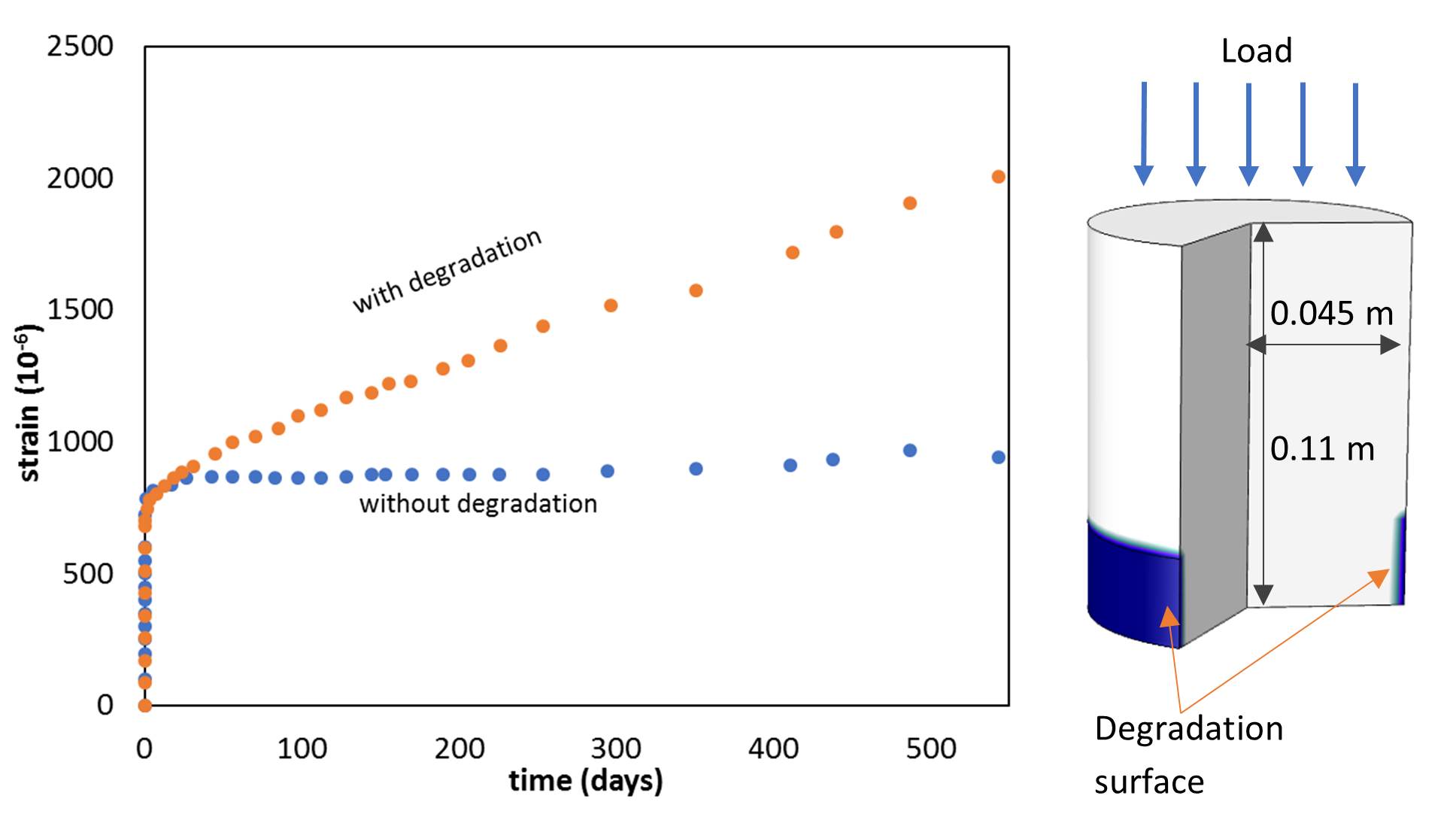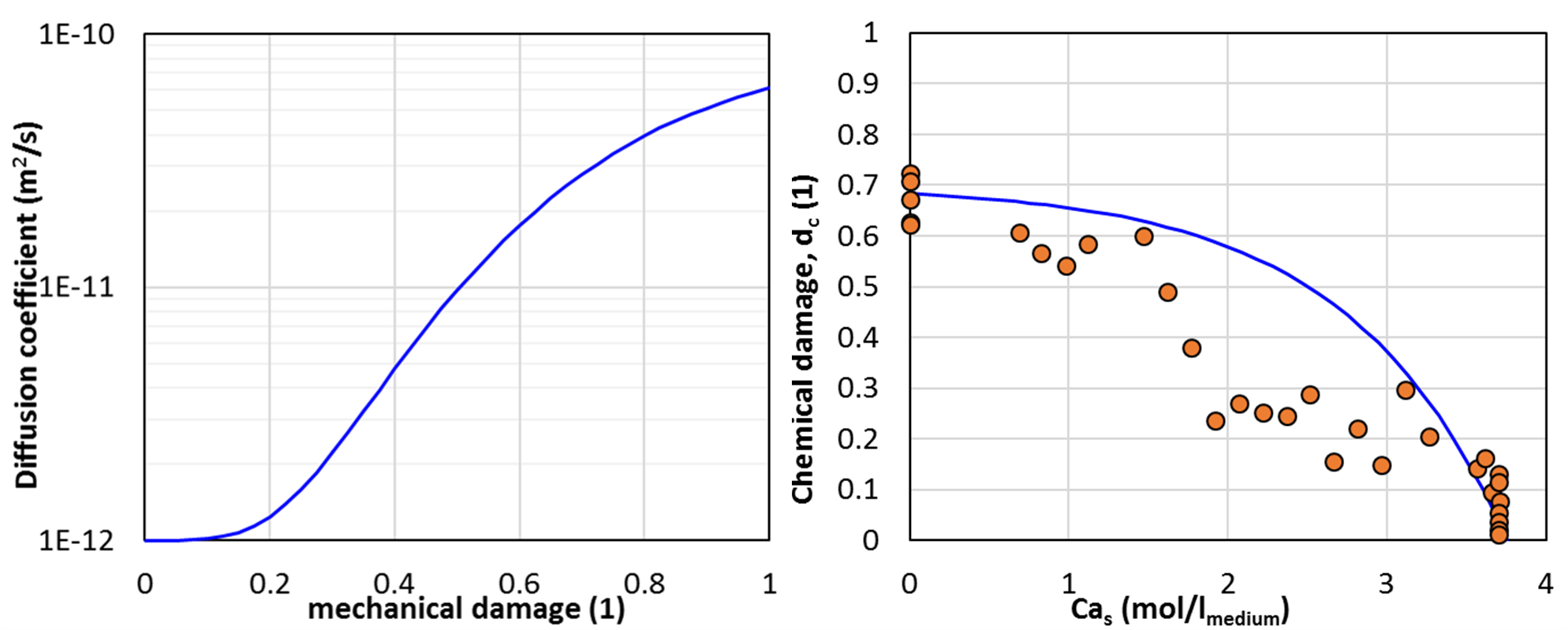- Published on
Chemo-mechanical coupled behaviour of cement-based materials
- Authors
Author
- Name
- Marcelo Laviñamail

Motivation
In civil engineering, the design of concrete structures needs to consider durability and long-term performance issues more than ever if sustainability is sought. The mechanical performance of concrete structures can be severely affected by the chemical interaction between concrete and the environment. These degradation processes must be accounted for to properly predict the long-term performance of structures during their service life. Accounting for such chemo-mechanical couplings requires robust and efficient numerical tools based on sound knowledge about how to conceptualize such couplings.
In this context, iCP version 2.0 offers the possibility of fully coupling chemical (C) and mechanical (M) processes (i.e., C → M and M → C) in reactive transport simulations. In this blog post, we show how to simulate the deformation of a concrete sample under the simultaneous action of chemical degradation and mechanical loading using iCP (Nardi et al., 2014).
Model description
Experimental data from Camps (2008) on compression creep tests of concrete samples locally subjected to a 6 M ammonium nitrate solution (NH4NO3) is simulated with a coupled chemo-mechanical model. Sample geometry, boundary conditions and deformation results are summarized in Figure 1. Ammonium nitrate solutions have been used in experiments of concrete leaching in the past because the attack resembles that with pure water but with a kinetic rate which is up to 200 times faster for high enough NH4NO3 concentrations (e.g. Carde et al., 1996). Ammonium nitrate causes dissolution of cement-based materials through the reaction between ammonium nitrate and calcium hydroxide in the cement paste. The reaction is expressed in equation 1.

Following the experimental setup, the model couples reactive transport (RT) processes under water-saturated and isothermal conditions with a solid mechanics model. However, variably saturated and non-isothermal conditions could be easily added in a more general case. The chemical composition of the concrete sample (made with CEM V), its porosity (0.11), and the aggregate volume fraction (0.64) are defined from the data given in Hu et al. (2014). Solute transport is simulated by Fickian diffusion with a single pore diffusivity for all dissolved species to maintain electroneutrality. The effective diffusion coefficient of concrete is modelled as a function of porosity and mechanical damage. The influence of damage is included as an S-shape function (equation 2; Figure 2) following Gérard et al. (1998). The value of the diffusion coefficient in the absence of chemical attack () is fixed to 1.0·10-12 m2/s, while is the diffusivity of a completely cracked material (1.0·10-10 m2/s). n and are model parameters (, ) and d_m is the mechanical damage variable. A tailor-made simple mechanical damage model is implemented for this test. A scalar damage value based on axial compressive strain of the sample is used (equation 3). The current axial strain () is weighed by a strain threshold value (). It is noted that in this approach we compute as a post-process of the mechanical behaviour, without any impact on the mechanical constitutive model (equation 3). More realistic damage models can also be implemented in Comsol (as demonstrated here) but the one used here is enough to demonstrate the coupled C-M behaviour.
Concrete is modelled as a linear elastic material but introducing the effect of chemical damage, , as in classical damage mechanics theory (Kachanov, 1986). This simple approach is defined by a Young’s modulus of the intact material, , of 43 GPa and a Poisson’s ratio of 0.27. For the sake of simplicity, no creep model is accounted for, which implies that time-dependent deformations are only considered in the model as a result of chemical damage. The chemical damage due to leaching is considered as a scalar variable and affects the Young’s modulus () as a function of calcium content in the concrete solid skeleton, (Gérard et al., 1998; Hu et al., 2014; Figure 2):

Results
The mechanical load applied to the sample is constant and equal to 37.6 MPa, resulting in an instantaneous deformation. If no chemical attack is considered, no further deformations are observed (recall that no creep is considered for simplicity). In contrast, when the exposure to ammonium nitrate is modelled, the mechanical properties of the concrete sample are gradually reduced with solid calcium content being leached. In the latter case, deformations gradually increase in time as the material stiffness decreases (Figure 3-right).
The impact of mechanics on the chemical scheme is shown when comparing the results in the centre of Figure 3 (no coupling of damage on ) and those on the right (fully coupled model). If this coupling is disregarded, Ca content in the solid skeleton decreases with a lower rate. The temporal evolution of effective diffusion coefficient in the sample is shown in Figure 4 together with the distribution of mechanical damage variable.
Model results are in relatively good agreement with experimental ones (Figure 5), despite the simplicity of the coupled chemo-mechanical model. Deformation after 500 days is doubled for the sample exposed to ammonium nitrate.

Concluding remarks
The performance of concrete and other cementitious materials under the simultaneous action of mechanical loading and chemical degradation (ammonium nitrate attack) can be properly modelled by means of fully coupled chemo-mechanical models in iCP version 2.0. A two-way coupled scheme between chemistry to mechanics has been implemented. The presented example shows the capabilities of iCP v2.0 to handle CM fully coupled processes.
References
Camps G, 2008. Etude des interactions chemo-mécaniques pour la simulation du cycle de vie d’un élément de stockage en béton. Ph.D thesis, Paul Sabatier Univ. Toulouse, Toulouse, France (in French).
Carde C, François R, Torrenti J M, 1996. Leaching of both calcium hydroxyde and C-S-H from cement paste: modeling the mechanical behaviour, Cement and Concrete Research, 28 (6), 1257-1268. https://doi.org/10.1016/0008-8846(96)00095-6
Gérard B, Pijaudier-Cabot G, Laborderie C, 1998. Coupled diffusion-damage modelling and the implications on failure due to strain localization. International Journal of Solids and Structures 35, 4107-4120. https://doi.org/10.1016/S0020-7683(97)00304-1
Kachanov L M, 1986. Introduction to Continuum Damage Mechanics. M. Nijhoff, Dordrecht, Boston, MA. https://doi.org/10.1007/978-94-017-1957-5
Nardi A, Idiart A, Trinchero P, de Vries L M, Molinero J, 2014. Interface COMSOL-PHREQC (iCP), an efficient numerical framework for the solution of coupled multiphysics and geochemistry. Computers & Geosciences 69, 10-21. https://doi.org/10.1016/j.cageo.2014.04.011
Hu D, Zhou H, Zhang F, Shao J, 2014. Modeling of short- and long-term chemomechanical coupling behavior of cement-based materials. ASCE, Journal of Engineering Mechanics, 206-218. https://doi.org/10.1061/(ASCE)EM.1943-7889.0000639